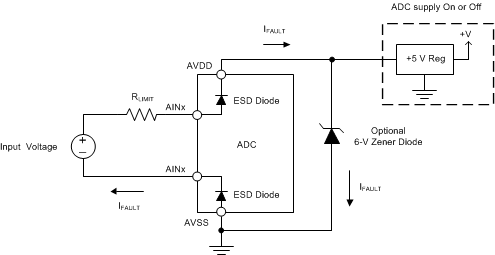SBAS824 October 2018 ADS1235
PRODUCTION DATA.
- 1 Features
- 2 Applications
- 3 Description
- 4 Revision History
- 5 Pin Configuration and Functions
- 6 Specifications
- 7 Parameter Measurement Information
-
8 Detailed Description
- 8.1 Overview
- 8.2 Functional Block Diagram
- 8.3 Feature Description
- 8.4
Device Functional Modes
- 8.4.1 Conversion Control
- 8.4.2 Chop Mode
- 8.4.3 AC-Bridge Excitation Mode
- 8.4.4 ADC Clock Mode
- 8.4.5 Power-Down Mode
- 8.4.6 Reset
- 8.4.7 Calibration
- 8.5 Programming
- 8.6
Register Map
- 8.6.1 Device Identification (ID) Register (address = 00h) [reset = Cxh]
- 8.6.2 Device Status (STATUS) Register (address = 01h) [reset = 01h]
- 8.6.3 Mode 0 (MODE0) Register (address = 02h) [reset = 24h]
- 8.6.4 Mode 1 (MODE1) Register (address = 03h) [reset = 01h]
- 8.6.5 Mode 2 (MODE2) Register (address = 04h) [reset = 00h]
- 8.6.6 Mode 3 (MODE3) Register (address = 05h) [reset = 00h]
- 8.6.7 Reference Configuration (REF) Register (address = 06h) [reset = 05h]
- 8.6.8 Offset Calibration (OFCALx) Registers (address = 07h, 08h, 09h) [reset = 00h, 00h, 00h]
- 8.6.9 Full-Scale Calibration (FSCALx) Registers (address = 0Ah, 0Bh, 0Ch) [reset = 00h, 00h, 40h]
- 8.6.10 Reserved (RESERVED) Register (address = 0Dh) [reset = FFh]
- 8.6.11 Reserved (RESERVED) Register (address = 0Eh) [reset = 00h]
- 8.6.12 Reserved (RESERVED) Register (address = 0Fh) [reset = 00h]
- 8.6.13 PGA Configuration (PGA) Register (address = 10h) [reset = 00h]
- 8.6.14 Input Multiplexer (INPMUX) Register (address = 11h) [reset = FFh]
- 9 Application and Implementation
- 10Power Supply Recommendations
- 11Layout
- 12Device and Documentation Support
- 13Mechanical, Packaging, and Orderable Information
10.2 Analog Power-Supply Clamp
It is important to evaluate circumstances when an input signal is present with the ADC, both powered and unpowered. When the input signal exceeds the power-supply voltage, it is possible to backdrive the analog power-supply voltage with the input signal through a conduction path of the internal ESD diodes. Backdriving the ADC power supply can also occur when the power-supply is on. The backdriven current path is illustrated in Figure 88. Depending on how the power supply responds during a backdriven condition, it is possible to exceed the maximum rated ADC supply voltage. The ADC voltage must not be exceeded at all times. One solution is to clamp the analog supply to safe voltage using an external zener diode.
 Figure 88. Analog Power-Supply Clamp
Figure 88. Analog Power-Supply Clamp